#editorial commercial publishing
Photo


Allure Korea March 2023
<Can Fine Dining be Sustainable?>
1 note
·
View note
Text
Living online means never quite understanding what’s happening to you at a given moment. Why these search results? Why this product recommendation? There is a feeling—often warranted, sometimes conspiracy-minded—that we are constantly manipulated by platforms and websites.
So-called dark patterns, deceptive bits of web design that can trick people into certain choices online, make it harder to unsubscribe from a scammy or unwanted newsletter; they nudge us into purchases. Algorithms optimized for engagement shape what we see on social media and can goad us into participation by showing us things that are likely to provoke strong emotional responses. But although we know that all of this is happening in aggregate, it’s hard to know specifically how large technology companies exert their influence over our lives.
This week, Wired published a story by the former FTC attorney Megan Gray that illustrates the dynamic in a nutshell. The op-ed argued that Google alters user searches to include more lucrative keywords. For example, Google is said to surreptitiously replace a query for “children’s clothing” with “NIKOLAI-brand kidswear” on the back end in order to direct users to lucrative shopping links on the results page. It’s an alarming allegation, and Ned Adriance, a spokesperson for Google, told me that it’s “flat-out false.” Gray, who is also a former vice president of the Google Search competitor DuckDuckGo, had seemingly misinterpreted a chart that was briefly presented during the company’s ongoing U.S. et al v. Google trial, in which the company is defending itself against charges that it violated federal antitrust law. (That chart, according to Adriance, represents a “phrase match” feature that the company uses for its ads product; “Google does not delete queries and replace them with ones that monetize better as the opinion piece suggests, and the organic results you see in Search are not affected by our ads systems,” he said.)
Gray told me, “I stand by my larger point—the Google Search team and Google ad team worked together to secretly boost commercial queries, which triggered more ads and thus revenue. Google isn’t contesting this, as far as I know.” In a statement, Chelsea Russo, another Google spokesperson, reiterated that the company’s products do not work this way and cited testimony from Google VP Jerry Dischler that “the organic team does not take data from the ads team in order to affect its ranking and affect its result.” Wired did not respond to a request for comment. Last night, the publication removed the story from its website, noting that it does not meet Wired’s editorial standards.
It’s hard to know what to make of these competing statements. Gray’s specific facts may be wrong, but the broader concerns about Google’s business—that it makes monetization decisions that could lead the product to feel less useful or enjoyable—form the heart of the government’s case against the company. None of this is easy to untangle in plain English—in fact, that’s the whole point of the trial. For most of us, evidence about Big Tech’s products tends to be anecdotal or fuzzy—more vibes-based than factual. Google may not be altering billions of queries in the manner that the Wired story suggests, but the company is constantly tweaking and ranking what we see, while injecting ads and proprietary widgets into our feed, thereby altering our experience. And so we end up saying that Google Search is less useful now or that shopping on Amazon has gotten worse. These tools are so embedded in our lives that we feel acutely that something is off, even if we can’t put our finger on the technical problem.
That’s changing. In the past month, thanks to a series of antitrust actions on behalf of the federal government, hard evidence of the ways that Silicon Valley’s biggest companies are wielding their influence is trickling out. Google’s trial is under way, and while the tech giant is trying to keep testimony locked down, the past four weeks have helped illustrate—via internal company documents and slide decks like the one cited by Wired—how Google has used its war chest to broker deals and dominate the search market. Perhaps the specifics of Gray’s essay were off, but we have learned, for instance, how company executives considered adjusting Google’s products to lead to more “monetizable queries.” And just last week, the Federal Trade Commission filed a lawsuit against Amazon alleging anticompetitive practices. (Amazon has called the suit “misguided.”)
Filings related to that suit have delivered a staggering revelation concerning a secretive Amazon algorithm code-named Project Nessie. The particulars of Nessie were heavily redacted in the public complaint, but this week The Wall Street Journal revealed details of the program. According to the unredacted complaint, a copy of which I have also viewed, Nessie—which is no longer in use—monitored industry prices of specific goods to determine whether competitors were algorithmically matching Amazon’s prices. In the event that competitors were, Nessie would exploit this by systematically raising prices on goods across Amazon, encouraging its competitors to follow suit. Amazon, via the algorithm, knew that it would be able to charge more on its own site, because it didn’t have to worry about being undercut elsewhere, thereby making the broader online shopping experience worse for everyone. An Amazon spokesperson told the Journal that the FTC is mischaracterizing the tool, and suggested that Nessie was a way to monitor competitor pricing and keep price-matching algorithms from dropping prices to unsustainable levels (the company did not respond to my request for comment).
In the FTC’s telling, Project Nessie demonstrates the sheer scope of Amazon’s power in online markets. The project arguably amounted to a form of unilateral price fixing, where Amazon essentially goaded its competitors into acting like cartel members without even knowing they’d done so—all while raising prices on consumers. It’s an astonishing form of influence, powered by behind-the-scenes technology.
The government will need to prove whether this type of algorithmic influence is illegal. But even putting legality aside, Project Nessie is a sterling example of the way that Big Tech has supercharged capitalistic tendencies and manipulated markets in unnatural and opaque ways. It demonstrates the muscle that a company can throw around when it has consolidated its position in a given sector. The complaint alleges that Amazon’s reach and logistics capabilities force third-party sellers to offer products on Amazon and for lower prices than other retailers. Once it captured a significant share of the retail market, Amazon was allegedly able to use algorithmic tools such as Nessie to drive prices up for specific products, boosting revenues and manipulating competitors.
Reading about Project Nessie, I was surprised to feel a sense of relief. In recent years, customer-satisfaction ratings have dipped among Amazon shoppers who have cited delivery disruptions, an explosion of third-party sellers, and poor-quality products as reasons for frustration. In my own life and among friends and relatives, there has been a growing feeling that shopping on the platform has become a slog, with fewer deals and far more junk to sift through. Again, these feelings tend to occupy vibe territory: Amazon’s bigness seems stifling or grating in ways that aren’t always easy to explain. But Nessie offers a partial explanation for this frustration, as do revelations about Google’s various product adjustments. We have the sense that we’re being manipulated because, well, we are. It’s a bit like feeling vaguely sick, going to the doctor, and receiving a blood-test result confirming that, yes, the malaise you experienced is actually an iron deficiency. It is the catharsis of, at long last, receiving a diagnosis.
This is the true power of the surge in anti-monopoly litigation. (According to experts in the field, September was “the most extraordinary month they have ever seen in antitrust.”) Whether or not any of these lawsuits results in corporate breakups or lasting change, they are, effectively, an MRI of our sprawling digital economy—a forensic look at what these larger-than-life technology companies are really doing, and how they are exerting their influence and causing damage. It is confirmation that what so many of us have felt—that the platforms dictating our online experiences are behaving unnaturally and manipulatively—is not merely a paranoid delusion, but the effect of an asymmetrical relationship between the giants of scale and us, the users.
In recent years, it’s been harder to love the internet, a miracle of connectivity that feels ever more bloated, stagnant, commercialized, and junkified. We are just now starting to understand the specifics of this transformation—the true influence of Silicon Valley’s vise grip on our lives. It turns out that the slow rot we might feel isn’t just in our heads, after all.
213 notes
·
View notes
Text
DAY 5973
Jalsa, Mumbai June 25/26, 2024 Tue/Wed 2:07 AM
Birthday - EF - Anamika Gupta .. 🙏🌹
Ef Özen Eren
Wednesday, 26 June .. and all ur prayers and wishes for this special day for the Ef ..
the Agenda .. an act of predetermined thought and conveyance .. what shall bring attention recognition be the intent .. any express that can remotely be given the spin, and mastered is the guile and expertise of such ..
it is lamentable , ignominious to witness the impotency of content .. to somehow in any which manner , to be able to draw attention in storied form, just so it can be put up and seen or read , in favourable condition to them that devise it ..
devise .. for the right is not needed to be devised ..
pity ..
never ever underestimate the generation that follows , or is about to follow .. they are aware and alive to every situation and knowledged to hold their own in debate or discussion ..
we are enriched by the circumstance that often fall upon us .. and then we find a way .. even when there be none ..
"In today's digital age, the ubiquitous nature of content has paradoxically led to a dilution of its potency. With the democratization of content creation, anyone with an internet connection can produce and distribute information, leading to an oversaturation of the digital landscape. This phenomenon has profound implications, rendering content less impactful and more ephemeral.
First, the sheer volume of content available online has created a paradox of choice. Every minute, hundreds of hours of video are uploaded to platforms like YouTube, thousands of blog posts are published, and millions of social media updates are posted. This relentless flow of information makes it difficult for any single piece of content to stand out. The audience, overwhelmed by options, often resorts to skimming or entirely ignoring vast amounts of content, diminishing its overall impact.
Moreover, the quality of content has become highly variable. While the ease of content creation has empowered many voices, it has also led to an influx of low-quality, poorly researched, and sometimes misleading or false information. This glut of mediocre content competes with high-quality, well-researched pieces, making it challenging for audiences to discern value and trustworthiness. As a result, even content of genuine worth can struggle to achieve the recognition and engagement it deserves.
Another critical factor contributing to the impotency of content is the algorithm-driven nature of content distribution. Social media platforms and search engines prioritize content based on engagement metrics such as likes, shares, and comments rather than the inherent quality or informational value. This prioritization often leads to the virality of sensational, clickbait content at the expense of substantive, insightful work. Consequently, the attention economy favors superficial engagement over deep, meaningful interactions with content.
Additionally, the fast-paced consumption habits of modern audiences further erode the potency of content. The average attention span has dwindled in the face of constant digital distractions. People increasingly consume content in bite-sized formats, such as tweets or short videos, which limits their exposure to in-depth analysis or comprehensive narratives. This shift towards brevity undermines the ability of content to foster nuanced understanding or sustained engagement.
The commercialization of content also plays a significant role in its diminishing impact. Content marketing has become a dominant strategy for businesses, leading to a proliferation of branded content. While this can provide value, it also contributes to the noise and can sometimes prioritize promotional messages over genuine, informative content. The blending of editorial and advertising content can lead to skepticism and diminished trust among audiences, further reducing the impact of the content they encounter.
Lastly, the fleeting nature of digital content means that it often has a very short lifespan. Unlike traditional media, which could have a lasting presence, digital content is quickly buried under the avalanche of new information. This ephemeral existence means that even impactful content can be forgotten rapidly as attention shifts to the next trending topic.
In conclusion, the impotency of content in today's times is a multifaceted issue stemming from the overwhelming volume of information, variable quality, algorithm-driven distribution, changing consumption habits, commercialization, and the ephemeral nature of digital content. To reclaim the potency of content, creators and platforms must prioritize quality, foster trust, and find ways to engage audiences meaningfully and sustainably amidst the cacophony of the digital age."
Love and more ..
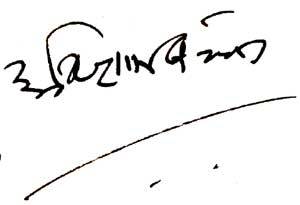
Amitabh Bachchan
115 notes
·
View notes
Text
You're the Risk I Want to Take
Oh... hello! well, no sunday snippet from me today, also because it's not Sunday anymore, but I do have something else to offer?
Inspired by a prompt by the amazing @dreamyelectronicmusic and after a month of teasing it (sorry about that) I give you: Chapter 1 of the editorial assistant AU (WIP, part 1/3, rated M)
When Simon, an editorial assistant at one of Sweden’s most prominent commercial publishing houses, stumbles upon a manuscript sent in by a mysterious W. Viklund, he doesn’t expect it to be any good. He certainly doesn’t expect to fall in love with it, or that the author is kind, and funny, and witty and keeps distracting him from his work.
Read it here on ao3
#maybe 1 am on a sunday night isn't the best time to post this#but formatting it took like. so much longer than i thought it would so we'll deal with it i guess#this is also bc ao3 kept fucking me over#but it's here!!!!#young royals#yr fanfic#yr fic#yr fanfiction#young royals fanfiction#young royals fanfic#young royals fic#young royals archive#wilmon#wilmon fanfiction#prince wilhelm#wilhelm eriksson now?#simon eriksson#you're the risk i want to take#editorial assistant au
49 notes
·
View notes
Text
Himalayan Linguistics turns 20: Celebrating two decades of Diamond Open Access publish
The publication of Himalayan Linguistics issue 23(1) marks 20 years of the journal. To celebrate this milestone, the current team of editors, including myself, teamed up with two key former editors to write a special editorial about the history of the journal. Below are some excerpts from this history, as well as the article list for HL23(1) and a newly published Archives piece.
In early 2004, the first issue of Himalayan Linguistics was published. This first issue contained a single article: “An Analysis of Syntax and Prosody Interactions in a Dolakhā Newar: Rendition of The Mahābhārata”, by Carol Genetti and Keith Slater. In 2024, with the publication of Issue 23.1, Himalayan Linguistics celebrates twenty years of publishing fee-free Open Access research scholarship on the languages of the Himalayas. In these twenty years, Himalayan Linguistics has published almost 200 pieces of scholarship, all freely available online. In this special introductory article, we chart the history of the journal and look to its future.
In its twenty years of publication, Himalayan Linguistics has published 144 original research articles, 18 review articles, and 14 Archive and Field Reports. The Archive publications include grammars, dictionaries, text collections and extended descriptive works.
Himalayan Linguistics is well-placed to continue into the next twenty years. Indeed, the need for accessible online journals, which do not gatekeep with article processing charges, is even greater. The rise of digital-first research publication has seen an even contraction and concentration in the publishing market, which is now predominantly an oligopoly of a few giant commercial publishers (Larivière et al. 2015). This landscape creates a barrier, particularly for scholars who cannot afford processing fees.
Himalayan Linguistics, Volume 23, Issue 1, 2024
Editorial: Twenty years of Himalayan Linguistics
Lauren Gawne, Gregory Anderson, You-Jing Lin, Kristine A. Hildebrandt, Carol Genetti,
Spoken and sung vowels produced by bilingual Nepali speakers: A brief comparison
Arnav Darnal,
A corpus-based study of cassifiers and measure words in Khortha
Netra P. Paudyal
The grammar and meaning of atemporal complement clauses in Assamese: A cognitive linguistics approach
Bisalakshi Sawarni, Gautam K. Borah
Possessive prefixes in Proto-Kusunda
Augie Spendley
Expressing inner sensations in Denjongke: A contrast with the general Tibetic pattern
Juha Sakari Yliniemi
New in Archives and Field Reports
Facts and attitudes: on the so-called ‘factual’ markers of the modern Tibetic languages [HL ARCHIVE 14]
Bettina Zeisler
You can read all of Himalayan Linguistics, always Open Access at: https://escholarship.org/uc/himalayanlinguistics
#linguistics#language#journal#open access#Himalayan Linguistics#academic publishing#diamond open access#research article
27 notes
·
View notes
Text

[ 📹 Scenes from the central Gaza Strip on Wednesday morning, from the moment when Israeli occupation fighter jets bombed a residential neighborhood, violently sending rubble and debris hundreds of meters through the air and endangering local residents who hide behind nearby buildings while trying to survive further Zionist attacks. ]
🇮🇱⚔️🇵🇸 🚀🏘️💥🚑 🚨
208 DAYS OF CONTINUOUS BOMBING AND SHELLING STILL DECIMATING CIVILIAN POPULATION OF GAZA
On the 208th day of "Israel's" ongoing special genocide operation in the Gaza Strip, the Israeli occupation forces (IOF) committed a total of 4 new massacres of Palestinian families, resulting in the deaths of 33 Palestinian civilians, mostly women and children, while another 57 others were wounded over the previous 24-hours.
It should be noted that as a result of the constant Israeli bombardment of Gaza's healthcare system, infrastructure, residential and commercial buildings, local paramedic and civil defense crews are unable to reach countless hundreds, even thousands of victims who remain trapped under the rubble, or who's bodies remain strewn across the streets of Gaza.
This leaves the official death toll vastly undercounted as Gaza's healthcare officials are unable to accurately tally those killed and maimed in this genocide, which must be kept in mind while considering the scale of the mass murder.
In the latest news from the Israeli occupation, Zionist Prime Minister Benjamin Netanyahu met with United States Secretary of State, Antony Blinken, in Jersusalem yesterday.
During the meeting, Netanyahu told the US's top diplomat that he would not accept an end to the genocide as part of any negotiated agreement with the Palestinian Resistance factions, according to an Israeli official with knowledge of the meeting.
“He told Blinken that we are interested in reaching a deal, and determined to topple Hamas,” the official is quoted as saying in the Israeli media.
The Prime Minister told Blinken that the Rafah operation does not hinge on a hostage deal with the Hamas Resistance movement, and would go on regardless of any agreements made.
“The Rafah operation does not depend on anything,” the Prime Minister's office told the occupation media, “Prime Minister Netanyahu made this clear to Secretary Blinken."
Blinken, for his part, reiterated the United States's position on the Rafah operation, according to State Department spokesperson, Matthew Miller, without clarifying what exactly the US position is.
While the Biden administration has said the Israeli occupation's planned invasion of Rafah would be a "red line", no consequences have been outlined as a potential response to the implementation of such an operation.
In other news, Turkiye has announced the country has joined onto South Africa's lawsuit in the International Court of Justice (ICJ) at The Hague, in the Netherlands, accusing the Israeli occupation of committing acts of genocide.
The announcement was made by Turkiye's Foreign Minister, Hakan Fidan, during a press conference held with his Indonesian counterpart, Foreign Minister Retno Marsudi, in Ankara.
“We in Turkey have decided to join the lawsuit filed by South Africa against Israel regarding genocide in the International Court of Justice," Fidan is quoted as saying.
The Turkish foreign minister added that it was essential to establish a Palestinian state and to implement a two-state solution. Fidan also pointed out that some Western countries have come to see the establishment of a two-state solution as inevitable, stressing that the Israeli occupation's crimes against the Palestinian people continues and must be halted.
While the world continued to be horrified by the events ongoing in Gaza, Israeli occupation Finance Minister, Bezalel Smotrich, came under fire from the Hebrew media for his repeated calls for genocide against Palestinians.
In an editorial published in the Israeli newspaper, Haaretz, the outlet called on the Netanyahu administration to fire Smotrich for his comments calling for the "annihilation" of all Palestinians.
In video clip published on Tuesday, the Israeli Finance Minister called for genocide using phrases from the Torah, including the statement, “I will pursue my enemies and overtake them, and I will not return until I have annihilated them."
Smotrich further called for the "complete" destruction of the Palestinian cities of Rafah, in the southern Gaza Strip, as well as Deir al-Balah, in the central Gaza Strip.
Further quoting from the Torah, Smotrich said, “I will erase the remembrance of Amalek from under the sky," referring to a peoples in the Torah who were completely annihilated; men, women and children alike for herecy.
Meanwhile, the Israeli occupation's actual genocidal operation in Gaza continues, with violent airstrikes and artillery shelling targeting all sectors of the Gaza Strip, killing and maiming dozens of Palestinian civilians.
On Tuesday evening, Israeli occupation shelling targeted a residential building in the Shaboura Refugee Camp, located in central Rafah, in the southern Gaza Strip, murdering two children, and wounding a number of others.
Local reporting stated that Israeli artillery detatchments shelled a civilian home belonging to the Abu Ghali family, in the Shaboura Camp, destroying the house and killing a small boy and his baby sister. The dead and wounded were evacuated to the Al-Kuwaiti Hospital in Rafah City.
In another atrocity, Israeli occupation artillery forces shelled homes in the Al-Husaynat neighborhood, east of Rafah, killing a Palestinian woman who died after being transported to the European Gaza Hospital.
Occupation air raids also targeted neighborhoods in the north and east of Rafah City, while intense bombing on Tuesday night targeting a residential apartment complex in the Nuseirat Refugee Camp, in the central Gaza Strip, leading to the deaths of three Palestinian civilians, including a child, and also wounding several others.
Similarly, occupation warplanes further bombed several residential blocks in the Al-Mughraqa area, in the central Gaza Strip.
In further war crimes and atrocities, occupation air forces bombed a group of civilians in the Al-Zahraa area, north of the Nuseirat Camp, resulting in the martyredom of three civilians.
A further Zionist air raid targeted a residential home in Deir al-Balah, in central Gaza, killing a woman belonging to the Al-Azayza family.
Medical sources in the Khan Yunis Governate said they'd recovered the bodies of 9 civilians from the Khan Yunis Camp, in the south of the city, while recovery efforts are still ongoing in the area.
Zionist artillery shelling went on to target Mansoura Street in the Al-Shujaiya neighborhood, east of Gaza City, wounding at least three civilians, while at the same time, IOF aircraft bombarded the Al-Zaytoun neighborhood, southeast of Gaza City, and also the town of Beit Lahiya, in the north of the enclave.
The bombardment resumed again at dawn on Wednesday, when Israeli occupation fighter jets bombed Al-Jalaa Street in Gaza City, killing three Palestinian civilians and wounding four others. Recovery efforts are ongoing by civil defense crews.
Yet more bombing by the Israeli occupation army targeted the east and north of Gaza City, and also bombed and shelled the Jabalia Refugee Camp, in Gaza's north.
As a result of "Israel's" ongoing special genocide operation in the Gaza Strip, the death toll among the local population has risen further still, now exceeding 34'568 Palestinians killed, including over 14'690 children and 9'680 women, while another 77'765 others have been wounded since the start of the current round of Zionist aggression, beginning with the events of October 7th, 2023.
May 1st, 2024.
#source1
#source2
#source3
#source4
#source5
#source6
#source7
#source8
#videosource
#graphicsource
@WorkerSolidarityNews
#gaza#gaza strip#gaza news#gaza genocide#genocide#genocide in gaza#israeli genocide#israeli war crimes#war crimes#crimes against humanity#palestine#palestine news#palestinians#free palestine#free gaza#end the occupation#war in gaza#israel#israeli occupation#israel palestine conflict#war#middle east#politics#news#geopolitics#world news#global news#international news#breaking news#current events
39 notes
·
View notes
Text
Biden Leaves His Successor a World of Disorder
His policies have encouraged the advance of U.S. adversaries across the globe.
By The Editorial Board -- Wall Street Journal
President Biden will address the United Nations on Tuesday, in what is likely to be his last big moment on the world stage. A President’s foreign-policy legacy typically outlasts his term, so it’s worth taking a step back and considering the world Mr. Biden will leave his successor.
It is a far more dangerous world than Mr. Biden inherited, and far less congenial for U.S. interests, human freedom and democracy. The latter is tragically ironic since the President has made the global contest between democracy and authoritarians an abiding theme. Authoritarians have advanced on his watch in every part of the world—Europe, Asia-Pacific, the Middle East, Africa, and even the Americas.
***
• Mr. Biden’s chaotic withdrawal from Afghanistan was his single most damaging decision, and it has led to cascading trouble. The Taliban control the country and are reimposing feudal Islamist rule. His withdrawal has done more harm to more women than anything in decades, while jihadists have revived their terror sanctuary.
• More damaging is the message his withdrawal sent to adversaries about American will and retreat. The credibility of U.S. deterrence collapsed. Mr. Biden tried to appease Vladimir Putin by blessing the Nord Stream 2 pipeline and refusing to arm Ukraine. Mr. Putin concluded he could invade Ukraine at limited cost, especially after Mr. Biden blurted out that a “minor incursion” might not elicit the same Western opposition.
After Kyiv bravely resisted, Mr. Biden sent weapons, but too little and too delayed at every stage of the war. Even now, after 31 months and 100,000 or more dead, Mr. Biden dithers over letting Ukraine use long-range ATACMS against targets inside Russia.
• His record in the Middle East is worse. Rather than build on the Abraham Accords he inherited, he tried to ostracize Saudi Arabia and he banned offensive weapons to fight the Houthis. From the start he courted the mullahs in Iran to renew the 2015 nuclear accord that had enriched Iran before Donald Trump withdrew. He refused to enforce oil sanctions, even as Iran spread mayhem through its proxy militias.
The U.S. was caught flat-footed when Hamas, aided by Iran, invaded Israel and massacred 1,200 innocents. His national-security adviser, Jake Sullivan, had to edit an online version of a Foreign Affairs essay already published boasting that “the region is quieter than it has been for decades.”
Here’s how quiet: Our foremost regional ally is now at war on multiple fronts. Israel’s defensive campaign in Gaza isn’t finished and a new and perhaps bloodier fight is unfolding with Hezbollah. The Houthis have all but shut down Western commercial shipping around the Red Sea, while Mr. Biden makes U.S. naval commanders play whack-a-missile.
Meanwhile, Iran marches undeterred to becoming a nuclear power. The Biden Administration mouths pieties that this is unacceptable, but its every action suggests it believes a nuclear Iran is inevitable and trying to stop it is too risky. When Iran goes nuclear, the security calculus in the world will turn upside down.
• Mr. Biden’s record in the Asia-Pacific is marginally better, at least diplomatically. He has strengthened U.S. alliances against China, especially with Australia, Japan and the Philippines. The Aukus defense deal is important, as is Japan’s move toward closer military integration with the U.S.
Yet diplomacy hasn’t been matched by hard power. The U.S. isn’t building enough submarines to meet its Aukus commitment and U.S. needs. American bases lack adequate air defenses and long-range missiles to defeat a Chinese invasion of Taiwan. State Department foot-stomping hasn’t stopped Chinese harassment of Philippine ships.
• Closer to home, Venezuela’s dictator has predictably stolen another election, exposing the Biden Administration’s deal to ease oil sanctions as naive. Mexico is tilting in an authoritarian direction without U.S. protest. Cuba continues to spread revolution wherever it can. The resulting human suffering reaches America in the flood of migrants that now burden our cities, from Manhattan to Springfield, Ohio.
• Most ominous is the collaboration of these menacing regional powers into a new anti-Western axis. Iran supplies missiles and drones to Moscow, which may be supplying nuclear know-how to Tehran. China is aiding Moscow, which now joins Beijing in naval maneuvers. North Korea also arms Moscow while being protected by China from United Nations sanctions it once voted for.
***
All of this and more adds up to the worst decline in world order, and the largest decline in U.S. influence, since the 1930s. Yet Mr. Biden continues to speak and act as if he’s presided over an era of spreading peace and prosperity. He has proposed a cut in real defense spending each year of his Presidency, which may be his greatest abdication.
Addressing this gathering storm will be difficult and dangerous. The first task will be restoring U.S. deterrence, which will require more hard power and political will. Whoever wins the White House will have to abandon the failed policies of the Biden years, lest we end up careening into a global conflict with catastrophic consequences.
Appeared in the September 23, 2024, print edition as 'How Freedom Faded on Biden’s Watch'
REPOST THIS EVERY TIME
#Biden#Harris#Democrats#Obama#weak america#trump#trump 2024#president trump#ivanka#repost#america first#americans first#donald trump#america#REPOST THIS
16 notes
·
View notes
Text
"space case": the pre-2005 martin jordan
these days the quintessential hal jordan is easily defined by two traits: a distinct lack of fear, and a penchant for wearing his father's air force jacket. hal's father is his hero, you all know that. or, that's what you've been led to believe by the post-2005 geoff johns era of green lantern that has completely overshadowed everything that had come before and worked hard to erase the slightest hint of friction between hal & his father.
first things first, the post-2005 continuity can be looked at as half a fanboy's wish and half editorial mandate -- the biggest inspiration for hal's hero worship of martin (+ the whole deal with his jacket) and his overall attitude comes from darwyn cooke's elseworlds dc: the new frontier 2004, its unparalleled commercial success was undoubtedly a leading factor in the changes that followed and cooke had once spoken about being asked to work on green lantern secret files and origins 2005 (the one-shot that would jumpstart the 2005 ongoing series after the rebirth miniseries) for precisely that reason.

(graphic ink: the art of darwyn cooke)
secondly, for thirty (count 'em!) years of hal jordan's existence there had been no mention of his parents whatsoever. he had brothers, cousins, uncles come in and out of his life throughout green lantern 1960 but never parents. that all changed in 1989 with green lantern: emerald dawn #1, the first real attempt to give hal an origin (see below).
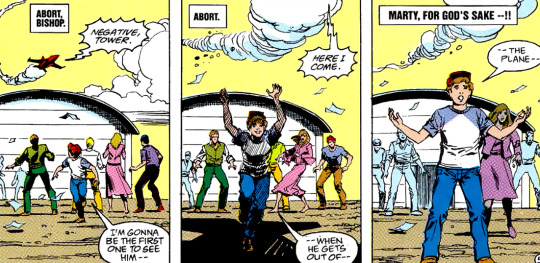
lastly and most importantly, martin had undoubtedly been an abusive father to hal and remained one of his few deep deep actual fears.
i'll be your guide through these pre-2005 appearances and mentions of martin and his relationship with hal, presented in chronological order based on real life release dates rather than internal chronology.


("you just can't make me proud of you, can you, son?" emerald dawn 1989 #2)

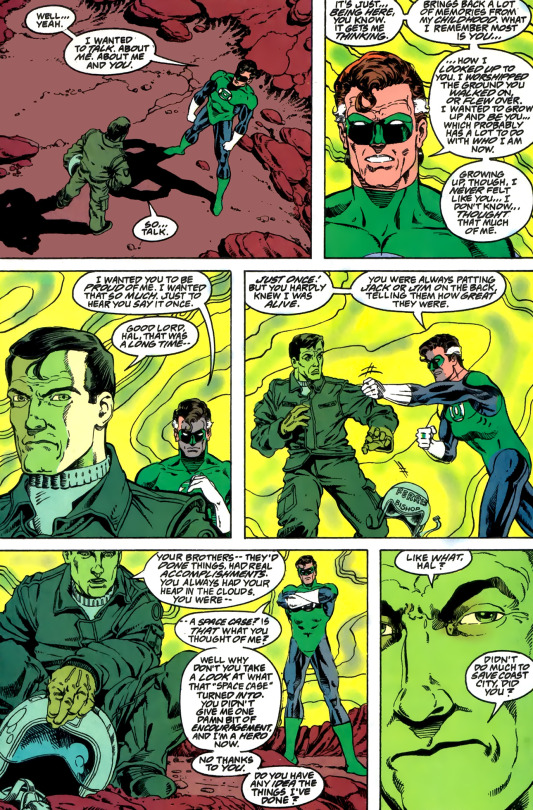
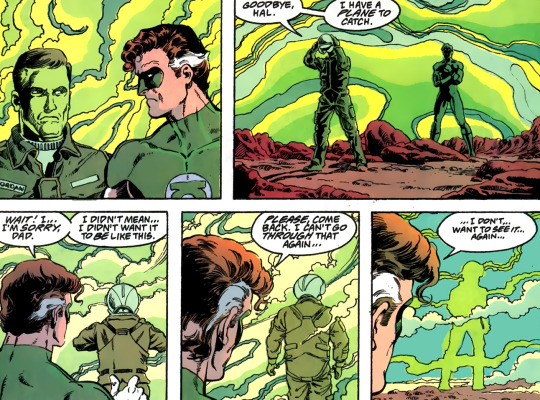
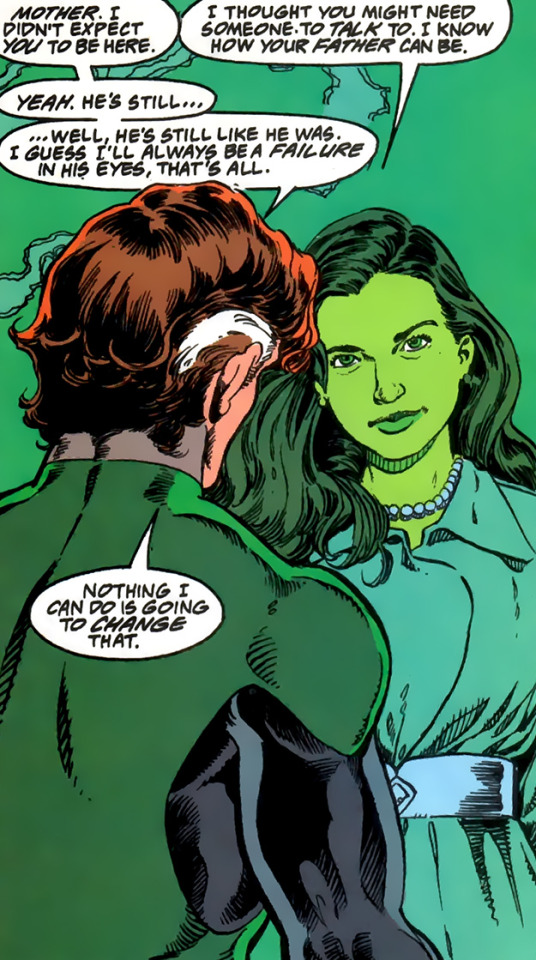
("well, he's still like he always was. i guess i'll always be a failure in his eyes, that's all. nothing i can do is going to change that", green lantern 1990 #48, published 1994)

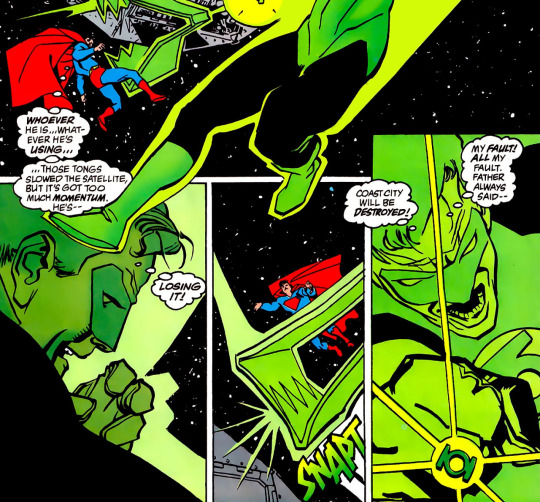
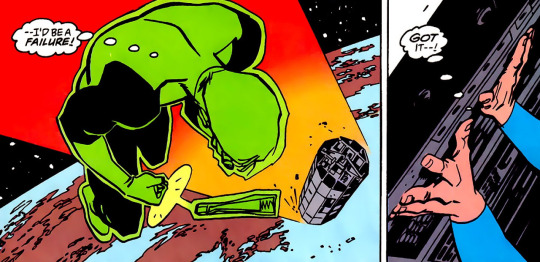
("my fault! all my fault. father always said i'd be a failure!", superman: the man of steel (1991) annual #4, published 1995)
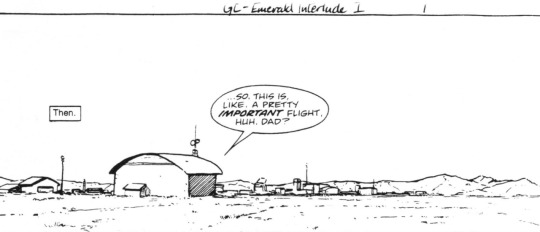
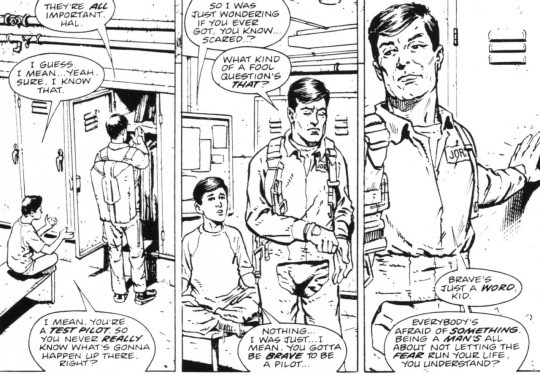

("the problem with you, hal, is you always got your head in the clouds", unpublished 'emerald interlude' originally slated for legends of the dc universe 1998 #33)

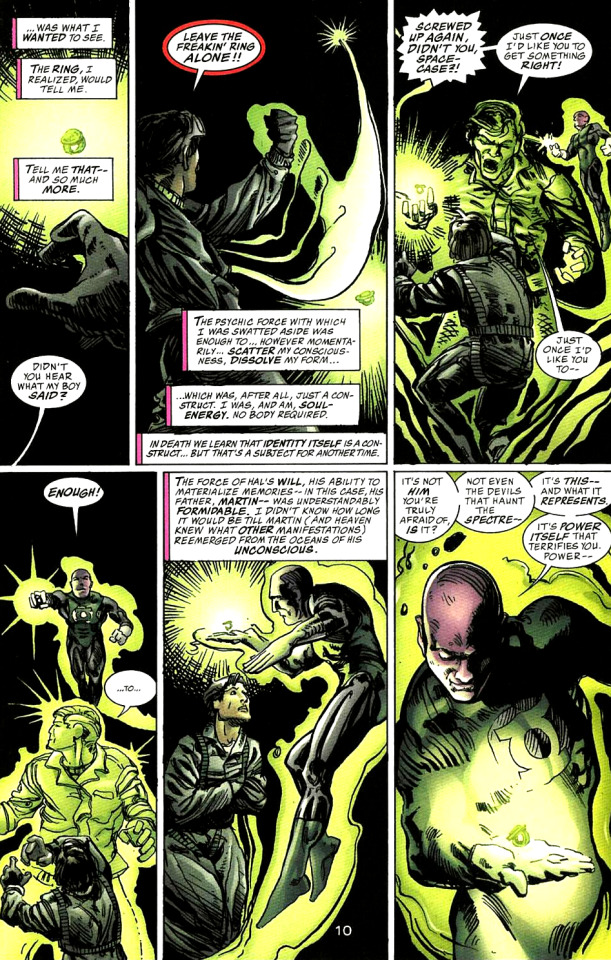
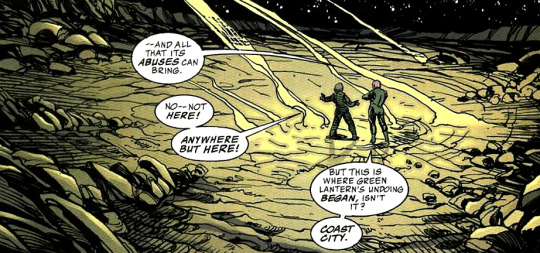
("screwed up again, didn't you, space-case?! just once i'd like you to get something right!", legends of the dc universe 1998 #35, published 2000)




("you become what you know. and what you didn't know you knew. like what you learn at the end of someone's arm. you learn to go blank. like maybe things with him would change if you could just give him what he wants. if you could just take it like a man", dc comics presents: green lantern 2004 #1)
interestingly enough, each of these stories is the work of different writers and between legends of the dc universe and dc comics presents: green lantern the narrative woven throughout becomes explicit -- hal perceives martin's abuse as abuse of power first and foremost, and doesn't just fear becoming 'what he knows' but also fears that he already did by abusing the power of the green lantern as parallax. all in all, it's an incredibly complex narrative seldom afforded to superheroes nowadays and an entirely vital part of hal's characterisation that we've been robbed of for far too long now.
#hal jordan#martin jordan#green lantern#abin sur#oliver queen#green arrow#superman#clark kent#green lantern corps#glc#justice league#justice league of america#jla#dc#dc comics#u can reblog#cw child abuse#very rushed hope its readable. had to get it out there
139 notes
·
View notes
Text
One Hundred Years Ago, Cincinnati Radio Was Still Trying To Get Its Act Together
New technologies consistently discombobulate the social order. So it was when some canny entrepreneurs began exploring the potential of this new-fangled sensation called radio. The electronic medium was so shockingly different from anything that came before, many graybeards announced radio was only a transient mania. The Cincinnati Post [6 March 1924] objected:
“In spite of current rumors that public enthusiasm over the radio is a ‘passing fad’ and is due for a slump, several electrical authorities who contributed to a survey of the sales for 1923 and to estimate the probable sales for 1924 reported that the sales this year are due to climb another $120,000,000.”
An editorial in the Cincinnati Enquirer [20 July 1924] hailed the growing commercialization of radio and predicted only amazing improvements ahead:
“With new ideas, new apparatus and new experimenters appearing in the radio field each day, radio is entering the greatest year of its development.”
Despite such optimism, the situation on the airwaves suggested that radio had yet to get its act together. Even though Cincinnati’s newspapers devoted page after page to coverage of this emerging phenomenon – the Enquirer printed a 12-page radio section every Sunday throughout 1924 – getting access to radio was still something of a challenge.
Cincinnati’s Crosley Corporation offered bargain-basement radio sets for the low, low price of $10, but that still equates to $200 in today’s money. Top-of-the-line Wurlitzer sets, at $180 in 1924, would cost more than $3,000 today. Throughout the year, almost every issue of every Cincinnati newspaper printed wiring diagrams so readers could build their own crystal sets.
All of this excitement was occurring at a time when Cincinnati had only two part-time radio stations: WLW, owned by the Crosley Corporation, and WSAI, owned by U.S. Playing Cards in Norwood. Both of those stations broadcast on the same frequency, 309 meters (equivalent to 970 kilohertz).
On a typical day, WLW broadcast from 10:30 a.m. to 5:00 p.m., then turned the airwaves over to WSAI from 5:00 p.m. to 10:00 p.m., then WLW returned to the air until about midnight. The federal government back then assigned frequencies to cities, not to individual stations. All stations in each city had to share that city’s frequency.
In effect, every radio station was a clear-channel operation because no other stations operated on that frequency. Consequently, as listeners rotated their dials, they could enjoy broadcasts from throughout the continental United States. Cincinnati newspapers published radio schedules from New York, Chicago, Pittsburgh, St. Louis, Los Angeles and other cities.
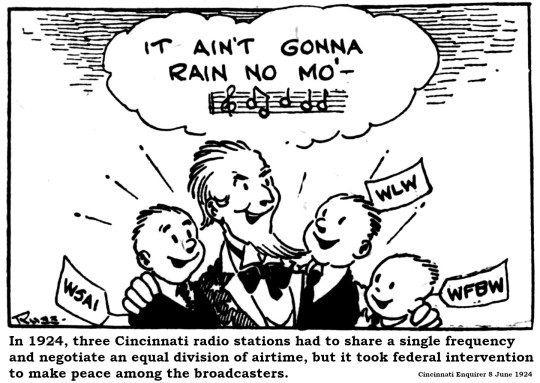
All was well until the end of May that year when a third radio station, WFBW (predecessor to WKRC), began broadcasting from the Hotel Alms on the assigned Cincinnati frequency. Since WLW and WSAI had mutually agreed to schedule around each other, there was little airtime left to allocate to this upstart. Negotiations went nowhere. Powel Crosley was unwilling to give up a single minute of his airtime. The dispute, dubbed “Battle of the Air” by the local press, was finally resolved when the feds reassigned WLW to the 423 meter (708 kilohertz) frequency. WLW had to share that frequency with WBAV out of Columbus, Ohio.
Another big development from 1924 was a lawsuit. Jerome F. Remick & Co., a New York music publishing company, sued WLW radio because the station broadcast a performance of the song, ��Dreamy Melody,” copyrighted by Remick. United States District Judge Smith Hickenlooper dismissed the case in a victory for radio broadcasters. Hickenlooper’s legal logic demonstrates just how disruptive radio, as a new medium, could be. Grasping for any precedent, Judge Hickenlooper noted that player piano rolls do not violate copyright each time they are played. A year later, an appeals court tossed Hickenlooper’s opinion onto the judicial trash heap and the copyright debate dragged on for decades.
Ignoring the legal and administrative haggling, what did Cincinnatians listen to in 1924? The local airwaves carried some surprisingly curious programming back then, although access to radio stations was strictly limited to white folks.
For instance, a heartbeat. On 17 February 1924, Miss Frances C. Jones, employed by WSAI as an accompanist, made radio history by broadcasting the sound of her heart. Next day, the Cincinnati Post was exuberant:
“The heartbeats were audible to listeners all over the country. Persons living thousands of miles from Cincinnati reported the ‘thump-thumps’ were heard on loud speakers.”
A month later, WLW introduced a barking dog named Nana-Hats-Off who accompanied her owner, Dr. Glenn Adams, secretary of the Cincinnati Kennel Club, to promote a dog show at Music Hall.
Cincinnati stations broadcast a lot of talk, and much of it sounds rather soporific. WLW gave Municipal Judge W. Meredith Yeatman a half-hour to expound upon “Automobile and Traffic Ethics.” Bleecher Marquette of the Better Housing League rambled about residential conditions in Cincinnati. Every speech from the annual dinner of the Cincinnati Bankers Club was broadcast in its entirety, no doubt to the delight of the populace. Dr. W.A. McCubbin fulminated for most of an hour on WSAI against fungi and bacteria.
The really popular programs offered an unusual mix of music. There were piano recitals, chimes concerts, vocal sextettes singing “old-fashioned” songs, violin solos, and musical performances from Emery Auditorium and the downtown hotels. The really, really popular broadcasts featured that nascent abomination, jazz. Alfred Segal, longtime Cincinnati Post columnist who, under his penname Cincinnatus, was considered the conscience of the city, expressed his exasperation [13 March 1924]:
“Sometimes Cincinnatus wonders that the pure air does not rebel against the waves of jazz it must carry every night. Sometimes when he tunes in New York or Chicago, only to receive another saxophone blast, Cincinnatus says to himself, ‘Was this wonderful thing invented for this – to disturb the heavens with discord, to defy the stars with the noise of tinpans?’ If Mars is inhabited and if the inhabitants receive our radio concerts, they must often wonder at the nature of the earth-beings who fill the ether with such hideous sounds every night.”

11 notes
·
View notes
Text
The Vanguard of Assholes: first, fast, and loud. Also, not worth your worry.
What it feels like: “As aspec identities rise in visibility, the world is pushing back with organized aphobia and closed-mindedness, and we’re surrounded.”
What it’s more like: “Most of the world has no idea you even exist yet, because they’ve been busy with their own shit. But a few people hate everything new¹, and they’ve noticed that you’re showing up more and more, and they don’t like new things, so they’ve decided to turn into whatever your natural enemy is. This week, they’ll be aphobes, and next week, they’ll be concerned parents against bicycle lanes. They just pick new stuff, and hate on it. They are The Vanguard of Assholes.”

There’s always a Vanguard of Assholes who show up first, fast, and loud, as the “dissenting opinion” to anything new¹.
Study the history of every “new” thing that emerged into public consciousness, and you will see examples of the Vanguard of Assholes showing up first, fast, and loud, claiming to be “everyone”, as they try to push the new idea back out of public consciousness.
They come disguised as moral panics, reactionary causes, NIMBY protests, book-burnings, trucks covered in upside down flags, traditional values voters, disingenuous debate-me bros, and “this is just too much too soon” editorials… it’s the Vanguard, losing their shit because they’re terrified of something new.
But not far behind the Vanguard of Assholes are the more than 90% of people who don’t have an opinion about you, good or bad, and won’t have an opinion about you until they get to know you. Find a way to sidestep the Vanguard, and get to know people from the big majority, be your own representation, and often be the first real live aspec person they know.
Appendix A: “So we should just let them?”
Now, a fair question is, “Shouldn’t we confront the Vanguard, because don’t they also talk to the majority?” Nope. The Vanguard prefer to engage a small, friendly audience in their immediate orbit, or with the groups they’re trying to chase away, because they know the Vanguard is small. They’re hoping they’re a little bit bigger than the group they’re chasing². They know that whenever they try to talk to the majority, they’re dealt with in seconds, because they’re very obviously filled with hate-fear.
If a Vanguard aphobe went on network TV tonight, and talked about why Loveless needs to be pulled from Amazon and Audible, to protect kids from asexuality, the majority would rightly ask them, “What the Kentucky fried hell are you even talking about? Asex. Is that like… abstinence or something?” And when the majority did look up what Loveless was about, they’d be more likely³ to respond, “I don’t see a problem here, there were three asexual characters in a book that mentioned multitudes of people, and none of them made anyone else asexual,” or “Oh, I have a friend/coworker/classmate/relative who’s like that. Xey didn’t date…” and so on.
Footnotes:
¹ No, asexuality itself isn’t “new”—I’ve been asexual for all of my 53 years—but asexuality’s presence on cultural radar, as a thing of note, is relatively new. You can still fit all of the asexual characters in commercially available fiction or media into a single tour bus. Season 2 of Sex Education (the season with that clip), Angela Chen’s Ace, and Alice Oseman’s Loveless were all released or published in 2020. The Sunset aroace flag only dates back to 2018. The purple asexual flag only dates back to 2010, which makes it younger than the iPhone.
² Low estimates put us at around 1 to 2% of the population. Even if aphobes were 4% of the population—which they aren’t, but pretend they were—they might seem to outnumber us two to one, but that would still leave 94-95% of the world outside of the discourse, and not currently on anybody’s side, but not likely to be swayed to the irrational aphobe side. Not in 2024.
³ This is based on observation. I’ve come out to roughly a thousand people. Most are like, “Hey, glad you’re happy.” None were openly hostile (including people from a very diverse queer community, or my extremely religious and/or conservative friends). Fewer than five have asked me more about it because either they or someone close was possibly aspec.
8 notes
·
View notes
Photo



〈오색 찬란 실패담〉 정지음 지음. 알에이치코리아(RHK)
1 note
·
View note
Text

March 1985. Whatever else one may say about the Crisis on Infinite Earths, it was a triumph for truth in advertising: Worlds lived, worlds died, and the DC Universe was never the same. A cynic might add, "And nothing ever made sense again," since the event kicked off almost 40 years of retcons, revisions, and successive reboots, which DC used to internally describe as "white events," after the cataclysmic moment in CRISIS ON INFINITE EARTHS #10 where the original multiverse was shattered and recreated:

Even before the Crisis event was ever conceived, DC had a long history of fairly dramatic editorial and creative shifts, some of which hung on specific story events (like the de-powering of Wonder Woman in 1968) and some of which did not (like the inauguration of Batman's "New Look" in 1964). With the benefit of hindsight, it's possible to make some general observations about editorial revisionism and efforts to tear down and rebuild internal continuity:
It's ultimately easier (and more effective) to ignore than to change. When Julius Schwartz became Batman editor in 1964, he dispensed with many characters and concepts that had been staples under his predecessor, Jack Schiff, such as Batwoman and Bat-Mite. With one exception, there was no story explanation of where they'd gone — they just stopped showing up and were soon forgotten. The exception was Alfred the butler, who was killed off dramatically in DETECTIVE COMICS #328. When the producers of the 1966 Batman TV show decided to incorporate Alfred into that series, Schwartz was obliged to resurrect him, in a singularly preposterous way, after which he was regarded as indispensable. By contrast, while most of the characters who'd simply been ignored also returned, it was much later and generally in quite minor ways; their long absence reduced them to marginalia that could be incorporated or not, as seemed most useful.
Crossovers are the most serious and persistent enemy of change. The nature of company-owned comics is that the characters will inevitably show up in crossovers, team-ups, and events of various kinds, often written, drawn, and edited by people who aren't familiar with the finer points of the characters' history, inevitably resulting in troublesome contradictions, up to and including characters who were previously supposed to be dead inexplicably popping up alive. The more convoluted a change to a character or their history, the more likely that it will misrepresented, accidentally undone, or just ignored the next time the character shows up in a series other than their own.
A true line-wide reboot is commercially infeasible. A publisher like DC or Marvel has many different titles at once, and at any given time, some of them are selling better than others. If a title isn't selling well, there may be nothing to lose by rebooting it or making drastic changes to its characters and direction, but doing that to a series that's currently a hot seller is foolhardy. So, the bestsellers will generally stroll through a "white event" with only minor cosmetic adjustments, while weaker titles may undergo a whole series of radical reinventions. If the former bestseller goes into a slump and one of those radical reinventions transforms an underdog into a hit, the situation will be reversed. Surely this won't backfire later …
Timing is everything. A lot of the confusion that resulted at DC in the wake of the Crisis stemmed from the fact that different revisions happened at different times. For instance, the headaches surrounding Hawkman began in large part because of the editorial decision in 1990 not to treat the Tim Truman HAWKWORLD series as a kind of "Hawkman: Year One" (which is how it was conceived), but rather as a reboot, even though that threatened to retroactively remove the Hawks from books like JUSTICE LEAGUE, which had become very popular following its most recent revamp. This kind of thing creates situations where creative teams have to come up with desperate contrivances to explain retroactive changes to very recent stories. Having Hawkman and Hawkwoman stop showing for Justice League adventures for a while wouldn't have been a big deal, but trying to assert that the Hawkman and Hawkwoman who'd previously appeared were either never really there or were actually somebody else was another matter, and the problems this created were never fully resolved.
Continuity-tidying for its own sake is almost always a creative dead end. This is a lesson that Nelson Bridwell and Roy Thomas demonstrated over and over throughout the Bronze Age: It's one thing to have some flashbacks, if it serves the story, or maybe to retell a character's origin with a few nips and tucks, but if your main purpose is to explain, e.g., why Namor once wore the wrong shorts, the results are likely to be either silly or tedious. This hasn't stopped DC and Marvel from wasting a lot of ink and paper on specials and miniseries that exist to retell earlier stories in an updated, continuity-compliant manner, usually to no good end. The fundamental problem with such things is that their main object is to regurgitate familiar older stories (if they weren't familiar, there would be no point in retelling them) while urging readers who have read the original version (who are the most likely audience) to ignore their lying eyes. This is, with very, very few exceptions, a dismal exercise that routinely defeats even usually reliable creators like John Ostrander (see for example the tiresome 2001–2002 JLA: INCARNATIONS), and frequently results in yet more contradictions to explain or ignore.
The bottom line is that while you can blow things up all you want, the likelihood that they can be reassembled in a clearer, more cohesive way is really quite low, and diminishes the more frequently you try.
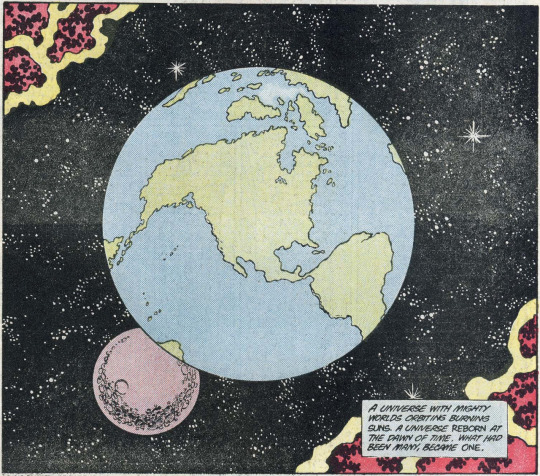
I want to be clear here that this isn't a criticism of the CRISIS ON INFINITE EARTHS series (which has many virtues, along with some significant flaws), or even any of the individual revisions and retcons that have followed, some of which are, in their own right, perfectly fine. The dilemma is that the project that an event like this represents is ultimately a doomed one. It might spark some commercial interest, at least briefly (which is of course at least half the point), but simplification and unity are just not in the cards and probably never will be.
#comics#crisis on infinite earths#marv wolfman#george pérez#jerry ordway#retcons#retroactive continuity#hawkworld (both the truman mini and the ostrander ongoing)#is actually quite good and its troublesome continuity impact#would have been almost entirely avoidable#just as the continuity headaches with wonder woman and donna troy#could have been avoided by treating the first year of the relaunched wonder woman series#as taking place “a few years ago”
22 notes
·
View notes
Text
The Observer view on Prince Harry’s court victory over Mirror Group Newspapers
Observer editorial
In his continuing campaign to bring the press to account for phone hacking, the Duke of Sussex may succeed where Leveson’s inquiry failed
Sun 17 Dec 2023 06.30 GMT

A smiling Prince Harry outside the Royal Courts of Justice, with photographers in the background.
In its defence of the civil court action brought by Prince Harry, Mirror Group Newspapers argued to the death that there was not a shred of evidence to support the Duke of Sussex’s claims of a lifetime of illegal information gathering and phone hacking. “Zilch, zero, nil, de nada, niente, nothing,” Andrew Green KC, the newspapers’ barrister, insisted in summing up. Piers Morgan, Mirror editor for much of the period in question, reiterated that denial – and took the opportunity to double down on his vindictive and blatantly self-serving assault on Harry’s reputation – in a prepared statement for the press on his doorstep on Friday. The damning 386-page judgment of Mr Justice Fancourt, published earlier that morning, tells a very different story, however.
In supporting Harry’s claims, and awarding him £140,600 in damages, it provides an exhaustive catalogue of evidence that “extensive and habitual” unlawful practices went on over a longer period at the Mirror than previously established; that the use of off-the-books private investigators and blaggers and hackers to capture personal details of Harry and his circle – and scores of other high-profile targets – was endemic at the Mirror’s three national titles from 1998 to 2011.
One dangerous consequence of these latest revelations has been renewed calls for legislative oversight of press freedom
The judgment also makes plain that the Mirror Group’s deletion of phone records and email evidence from the period, and the decision not to call senior editorial staff, including Morgan, to give evidence, must be understood as part of an ongoing culture of cover-up. What went on, the judge told the court, “was concealed from the board, from parliament in 2007 and 2011, from the Leveson inquiry, from shareholders and from the public for years”. Public trust in news, already serially undermined by political and commercial attacks, is again the victim of that denialism. One dangerous consequence of these latest revelations has been renewed calls for legislative oversight of press freedom, which a democracy must always resist.
Despite its denials, Mirror Group has paid out £100m to other litigants in out-of-court settlements. A further raft of cases will now no doubt follow. A previous test case brought by the Coronation Street actress Shobna Gulati established that, even in the absence of a full paper trail, it was clear the illegal practices were “generic” in the papers’ newsrooms from 2001 to 2006. In Mr Justice Fancourt’s assessment, the “generic” period could now extend between 1998 and 2011 – beyond both the arrest and conviction of the News of the World journalist Clive Goodman for similar practices in 2006, and – shockingly – Lord Leveson’s subsequent inquiry into the press.
When Harry first announced, five years ago, that he would make it his “life’s work” to seek justice for his family’s treatment by the tabloids, it was characterised – invariably in those same papers – as a fool’s errand. What his mission might now prove to be, however, is a half-workable replacement for the planned second phase of the Leveson inquiry, which was shamefully abandoned by Matt Hancock as culture secretary in 2018. That phase was due to examine the full extent of unlawful practice across the British press, the ways in which journalistic privileges designed, in all our interests, to hold the powerful and criminal to account in extremis, had been cynically “hijacked” to trade, at an industrial scale, in royal gossip and celebrity private lives.
Harry and others will bring further cases against Associated Newspapers’ Daily Mail and Rupert Murdoch’s Sun. It is to be hoped that the disclosure and defence of those actions may serve finally to establish the exact extent and limits of a culture that has been profoundly damaging to journalistic integrity and to British public life. In their notably scant reports of the judgment – a rare royal story in which they apparently have very little curiosity – neither paper referenced those forthcoming actions. No doubt, however, until the full truth is told, lawyers for both groups will continue to be exercised by little else.
11 notes
·
View notes
Text
"Ray's a Laugh" - Richard Billingham




What should a photo book be? A container for work? A physical reproduction of a bunch successful images? Or a work unto itself, in the tradition of the artist’s book, where book is the final formal goal ? To me, Ray’s a Laugh offers a high-water-mark affirmation of the latter. The body of work in this book is greater than any one image, the edit and sequence is brilliant, and the book speaks and lives for itself in an astounding way, a self-contained parable in its own humble world.
The work in this book was made in Billingham’s parents’ apartment in a small town in England, and centers on his father’s shut-in alcoholic lifestyle and his relationship with Billingham’s doting, caring mother. It’s a complex portrait of the whole family, posing playfully as a document but in reality functioning much more as impressionistic drama.
This work joins the likes of Larry Clark’s "Tulsa" and Nan Goldin’s “Ballad of Sexual Dependency” in the discussion of ethical/exploitative photography—is it right for Billingham to publish work that shows his family in extremely personal, vulnerable, and sometimes graphic situations? Is it right for him to characterize them as he does—deeply flawed, but charming and loving? Is it exploitative to aestheticize their poverty? These questions are complicated, but I think that given the personal nature of the work—Billingham’s own family being the subject—it’s hard for me to really condone or criticize the work either way. I don’t think of this book as benevolent or as evil, but as existing in the gray area of exchanging the privacy of loved ones for artistic honesty. I truly hope that this exchange was made in good faith.
As to the aesthetization, if we give Billingham the benefit of the doubt about the work being “authentic” (even if it’s such a flimsy adjective), it can be argued that the real, cynical commercial exploitation of poverty and addiction aesthetics is done downstream, when work like this starts popping up on moodboards for advertising and editorial photography, in commercial contexts, etc. On this topic, there’s a really fascinating publication called “Opioid Crisis Lookbook” that interrogates the culture of addiction and recovery from within the current North American opioid crisis, and I think it’s really good reading for anyone interested in this discussion. PDF here: https://theopioidcrisislookbook.com/issue-1/
Aside from the moral quandaries, I don’t mean to be grandiose when I say that to me, this book is a testament to the power of photography; a reminder to pick up the camera and observe, because something photographed is so different from something remembered. The work rides a fine line between earnestness and what could be considered callousness: gritty, dynamic photographs ostensibly about the reality of an alcoholic family member that are somehow stubbornly light-hearted and whimsical. Billingham engages in something like anti-humanist humanism, breaking up somber, revealing portraits with funny, detached snapshots of almost baroque scenes unfolding in the apartment day to day. This complexity makes me think about a consistent, obsessive photography practice, close observation of the intangible, and the simple, revealing power of a photograph.
In Ray’s a Laugh, Billingham is able to approach and re-approach the same people, the same spaces, and the same ideas, over and over, over the course of several months. The result is this magical, complex book that really satisfyingly blurs the lines of truth and fiction, and tragedy and comedy. What I think most draws me to this book is Billingham’s extremely present voice. He seems to function half as a family photographer and half as a photojournalist, moving jarringly back and forth between tenderness and a distant ambivalence. This is what endures for me, the ever-looming fiction of the work, which seems to almost allow the pictures to be more truthful and honest, at least about Billingham’s feelings. I think he offers us a way to see his family in the way that he does, focusing on silver lining and humble moments of joy while acknowledging pain and imperfection. This, to me, is the “magic of photography” Billingham reveals: the camera’s capacity, after a long while, to show who is behind the lens almost as clearly as who is in front of it.
I’ve come to the conclusion (sadly a bit late in the year) that what I would like to do is find some kind of concrete subject or container within which to make a project. I picture this as a body of work about a group of people, or a specific place, or maybe a subculture. I think I’ve had a tendency in the last few years of photographing to kind of reject the idea of any concrete focus, instead approaching my practice as “carry a camera everywhere, and let photographs come to me.” I’m reaching a point now where I’m frustrated with my “pile,” hundreds of one-off photographs tied together maybe only by my own experiences. When I first started photographing, Wolfgang Tillmans and Daniel Arnold were front and center in my mind. Their work, at least as I’d seen it presented, was less about concrete things and more about espousing a “way of seeing” (hence the MoMA show name “To Look Without Fear”). And while I think finding a primal, almost subconscious visual language is invaluable to a photographer (being able to look at a photo and regardless of subject having a feeling that this is ”a Noor photo”), my thinking on it as a conceptual framework has shifted. I think I was originally aiming for a body of work that was chaotic, all over the place, and vastly dynamic in subject matter. I now find this kind of framework to be a crutch for an under-edited project. In terms of Arnold, and in terms of books, I much, much prefer Matt Leifheit and Eve Lyon’s edit of Arnold’s work to that of his monograph, Pickpocket, because the former edit is tighter, more vulnerable, and “says” so much more than the latter collection of already-instagram-famous street photographs. I’m now much more interested in honing in on something, both through re-editing my old pile (over and over) and through changing what I’m photographing, so that I have some specific guiding light.
For final critique this year, I want to focus on an edit that is more intentional and revelatory, and most importantly, more vulnerable. What photographs have I been omitting that have more of myself in them? What can I do to narrow the perspective and get at something deeper? Thinking forward to this summer, I have set the goal to find some kind of “container” for what I shoot. I haven’t yet decided on one, but I’m thinking of things along the lines of “5th avenue, between 14th and 42nd,” or “Little League Baseball in Prospect Park.” Something I can go back to, week after week, something I can slow down and observe. I’m also including in this goal the qualification that I may break out of the container as I see fit. Through this container, I hope to apply my photographic intuition --which until now has been the whole story--to a more self-contained world.
PS. Mack recently reprinted Ray’s a Laugh with a new, expanded edit in a larger size than the original. It kind of feels like a deluxe edition album; I like the new plates that were added but only because I liked the original work so much. I feel like the expanded edit and coffee-table size (which kind of gives it what I call the “Phaidon vibe” :/) detract from the magic of the original’s concise edit and humbler physical size.
-Noor
6 notes
·
View notes
Text
Caught In The Middle of Change

There are some changes going on behind the scenes at Caughtlight Towers at the moment.
To be honest, a major change started happening just over 12 months ago, but with the commercial and editorial work flowing in at various times over the past year, it hasn't been fully completed.
Now as my involvement in a couple of sporting teams reduces, and a change in the way one of the media outlets is working in the past couple of weeks...it forces me to complete the journey that was started 14 months ago.
Over the winter months, there will be a new website, various new looks for social media channels, new software being used to process and store images, and a new relationship with the agencies we supply.
Sounds grandiose...but it's just change management really. People and companies need to continually evolve, and service their particular sector of the market in the right way.
The net effect at the moment, is that there has been a slight delay in getting images out...including this particular set. As told in another blog post, we're not an album kinda company...we've always preferred to publish a small set of curated images, rather than memory card dumpware...we like a small gallery of images that tell a story of a game/event, rather than 100+ images that become difficult to page through.
Hopefully, we will be providing a better service over the coming months, but there will be the odd hiccup or two...please bear with us!





























#photography#canon#sports#sport#harrogate#yorkshire#thoughts#business#york#cricket#Cricket Yorkshire#Harrogate Cricket Club#Cricket Club#Women's Cricket#WYWGCL#West Yorkshire
2 notes
·
View notes
Photo










Typography Tuesday
Women Type Designers: JIMENA GAMIO
Jimena Gamio is a Peruvian designer based in Los Angeles, who, as part of the 2021 Typographer-in-Residence program organized by the Hoffmitz Milken Center for Typography, designed a typeface called Mamá specifically for the indigenous Quechua language spoken in the Andean region of South America. The name Mamá comes from the Peruvian saying “Pachamama,” meaning mother earth gives to you, and you should give back. Gamio writes:
The compositions of curves and rectangles found in Peruvian architecture are the basis for Mamá; most of the letters were created with these same two shapes, based on the arched windows and angular doors, The forms are also inspired by the chunky, bold, and uneven typography that surrounded me while I grew up in Lima.
Jimena Gamio graduated with a BFA in Graphic Design from ArtCenter College of Design in Pasadena, California, where she currently teaches typography at the graduate level. Her design practice spans cultural and commercial clients, focusing on identity systems, editorial design, and typography. The examples shown here are from Quechua: The People’s Speech, one of four volumes in the set Mujeres Hispanas y Tipografía, a program highlighting the talent and creativity of Hispanic women designers, published in Pasadena, California by the Hoffmitz Milken Center for Typography in 2022.
The phrase in the first image, Ama Quella, is part of a popular saying among Quechua speakers in Peru, and means, “Do not be lazy.”

View posts on other Women Type Designers.
View more Women’s History Month posts.
View more Typography Tuesday posts.
#Typography Tuesday#typetuesday#Typography Tuesday#Jimena Gamio#women's history month#type designers#women type designers#women designers#Mamá typeface#Mama typeface#Quechua#Quechua language#Quechua: The People’s Speech#Mujeres Hispanas y Tipografía#Hoffmitz Milken Center for Typography#ArtCenter College of Design
28 notes
·
View notes